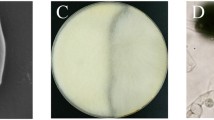Abstract
Trichophyton rubrum is an anthropophilic species that is the most frequent etiologic agent of human dermatophytosis throughout the world. No teleomorph has been identified for T. rubrum strains. This study used PCR analysis to confirm the presence of a mating type locus in the genome of Japanese isolates of T. rubrum. To clarify the epidemiological and ecological characteristics of this fungus, mating type sequences were tested for correlation of MAT genotype to mating type. This study examined clinical isolates of T. rubrum that had been obtained from 206 human cases of tinea pedis and tinea unguium in Japan, including those from Fukuoka (29 strains), Gifu (23 strains), Kanazawa (63 strains), and Tokyo (91 strains), along with 10 isolates derived from 10 cases of canine dermatophytosis. PCR detected the presence of MAT1-1 in all of the human and animal isolates. Therefore, all isolates examined were expected to react as (−) type on the mating test and not as (+) type.

Similar content being viewed by others
References
Kwon-Chung KJ, Bennett EJ. Dermatophytoses. In: Medical mycology. Philadelphia: Lea & Febiger; 1992. p. 130–132, 816–826.
Gräser Y, Scott J, Summerbell R. The new species concept in dermatophytes—a polyphasic approach. Mycopathologia. 2008;166:239–56.
Li W, Metin B, White TC, Heitman J. Organization and evolutionary trajectory of the mating type (MAT) locus in the dermatophyte and dimorphic pathogen. Eukaryot Cell. 2009;6:616–21.
Kano R, Yamada T, Makimura K, Kawasaki M, Mochizuki T, Kamata H, Hasegawa A. Arthroderma benhamiae (The Teleomorph of Trichophyton mentagrophytes) mating type-specific genes. Mycopathologia. 2011;171:333–7.
Kano R, Kawasaki M, Mochizuki T, Hiruma M, Hasegawa A. Mating genes of the Trichophyton mentagrophytes complex. Mycopathologia. 2012;173:103–12.
Hinrikson HP, Hurst SF, Lott TJ, Warnock DW, Morrison CJ. Assessment of ribosomal large-subunit D1–D2, internal transcribed spacer 1, and internal transcribed spacer 2 regions as target for molecular identification of medically important Aspergillus species. J Clin Microbiol. 2005;43:2092–103.
Gräser Y, Fröhlich J, Presber W, de Hoog S. Microsatellite markers reveal geographic population differentiation in Trichophyton rubrum. J Med Microbiol. 2007;56:1058–9.
Butler G. Fungal sex and pathogenesis. Clin Microbiol Rev. 2010;23:140–59.
Acknowledgments
This study was supported by Grants-in-Aid from the Academic Frontier Project of the Japanese Ministry of Education, Culture, Sports, Science and Technology (MEXT), and Grants-in-Aid from Nihon University. We thank Dr. T. Kasai (Kasai Dermatological Hospital), Dr. T. Kusunoki (Kusunoki Dermatological Hospital), Dr. M. Fujihiro, (Department of Dermatology, Ibi General Hospital), and Dr. H. Noguchi (Noguchi Dermatological Hospital) for providing the clinical isolates used in this study.
Author information
Authors and Affiliations
Corresponding author
Rights and permissions
About this article
Cite this article
Kano, R., Isizuka, M., Hiruma, M. et al. Mating Type Gene (MAT1-1) in Japanese Isolates of Trichophyton rubrum . Mycopathologia 175, 171–173 (2013). https://doi.org/10.1007/s11046-012-9603-2
Received:
Accepted:
Published:
Issue Date:
DOI: https://doi.org/10.1007/s11046-012-9603-2




